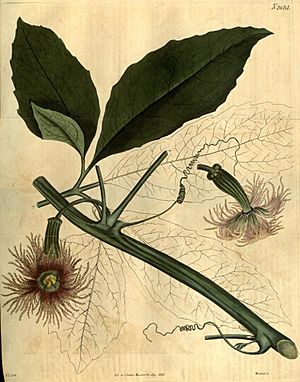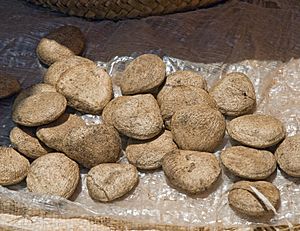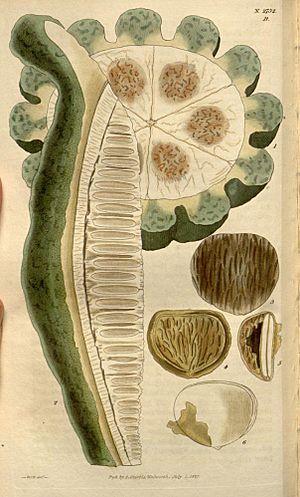Oysternut facts for kids
Quick facts for kids Oysternut |
|
|---|---|
 |
|
| T. pedata female flower | |
 |
|
| T. pedata male flower | |
| Scientific classification | |
| Genus: |
Telfairia
|
| Species: |
pedata
|
| Synonyms | |
|
|
The Telfairia pedata, often called oysternut, queen's nut, or Zanzibar oilvine, is a cool plant from Africa. It's a type of liana, which means it's a long, woody vine that can climb really high, sometimes up to 30 meters! This plant has pretty purple-pink flowers with fringes. It also grows very large, heavy fruits that look like big berries. These fruits can be 30 to 90 centimeters long and weigh up to 15 kilograms. The oysternut is special because its fruits, seeds, and the oil from its seeds are all edible and useful.
Contents
Growing Oysternut Plants
Oysternut plants are grown from their seeds. These seeds are black to reddish-brown and can be different sizes. Smaller seeds often grow better. The seeds don't like to dry out, and tiny fungi can cause them to spoil easily.
Where Oysternuts Live
Telfairia pedata loves warm, rainy places in the tropics. You can find it in forests near coasts and rivers. It also grows in higher places, like mountains, between 900 and 1800 meters above sea level, where it gets a good amount of rain each year.
In Tanzania, the oysternut vine often climbs on many different types of trees. Some of its favorite host trees include Albizia schimperiana, Persea americana (the avocado tree!), and Croton macrostaychs. Other common trees it likes to climb are Artocarpus heterophyllus (jackfruit), Cordia africana, Terminalia superba, Ficus sur, Rauvolfia caffra, Ficus thonningii, and Mangifera indica (mango).
Where Oysternuts are Found
The oysternut plant originally comes from Tanzania (including the Zanzibar Archipelago) and northern Mozambique. But people also grow it in many other African countries. These include Angola, Ethiopia, Kenya, Madagascar, Malawi, Mauritius, Nigeria, Rwanda, South Africa, Uganda, and Zambia. In Tanzania, it grows both in low coastal areas and in the highlands, like on the slopes of Mount Meru and Mount Kilimanjaro.
This plant is often found in higher altitudes, sometimes over 1500 meters up to 2000 meters, especially in areas that get a lot of rain.
How Oysternuts are Used
The fruits of the oysternut plant can be eaten, but the most valuable parts are its seeds, also called "nuts," and the oil made from them. The seeds taste great and can be cooked, roasted, or even eaten raw. Sometimes, they are given to new mothers to help them produce milk.
The oil from the seeds is mildly sweet and very useful. It's sold as ‘oyster-nut oil’ or ‘koémé de Zanzibar’. People use it for cooking, in cosmetics (like lotions), for making soap and candles. It's also used as a traditional medicine for stomach problems and rheumatism (joint pain). The Chaga people in Tanzania believe that a special drink made from the seeds is good for women who have just given birth. In the Pare mountains, people call it Makungu and eat the nuts fresh or roasted.
After the oil is pressed out of the seeds, the leftover part is still rich in fat and protein. This "cake" is then used as food for farm animals.
Oysternut Pests
Luckily, not many pests cause serious problems for the oysternut plant. However, one type of shield bug, called Piezosternum calidum, has been known to damage crops in Uganda. Other common pests, like grasshoppers and termites, can sometimes eat the entire plant, especially when many of them gather in a large group.
In Costa Rica, some oysternut vines have been attacked by borers, which are insects that dig into the main stem. This can be a serious problem and sometimes even kill the vines.



